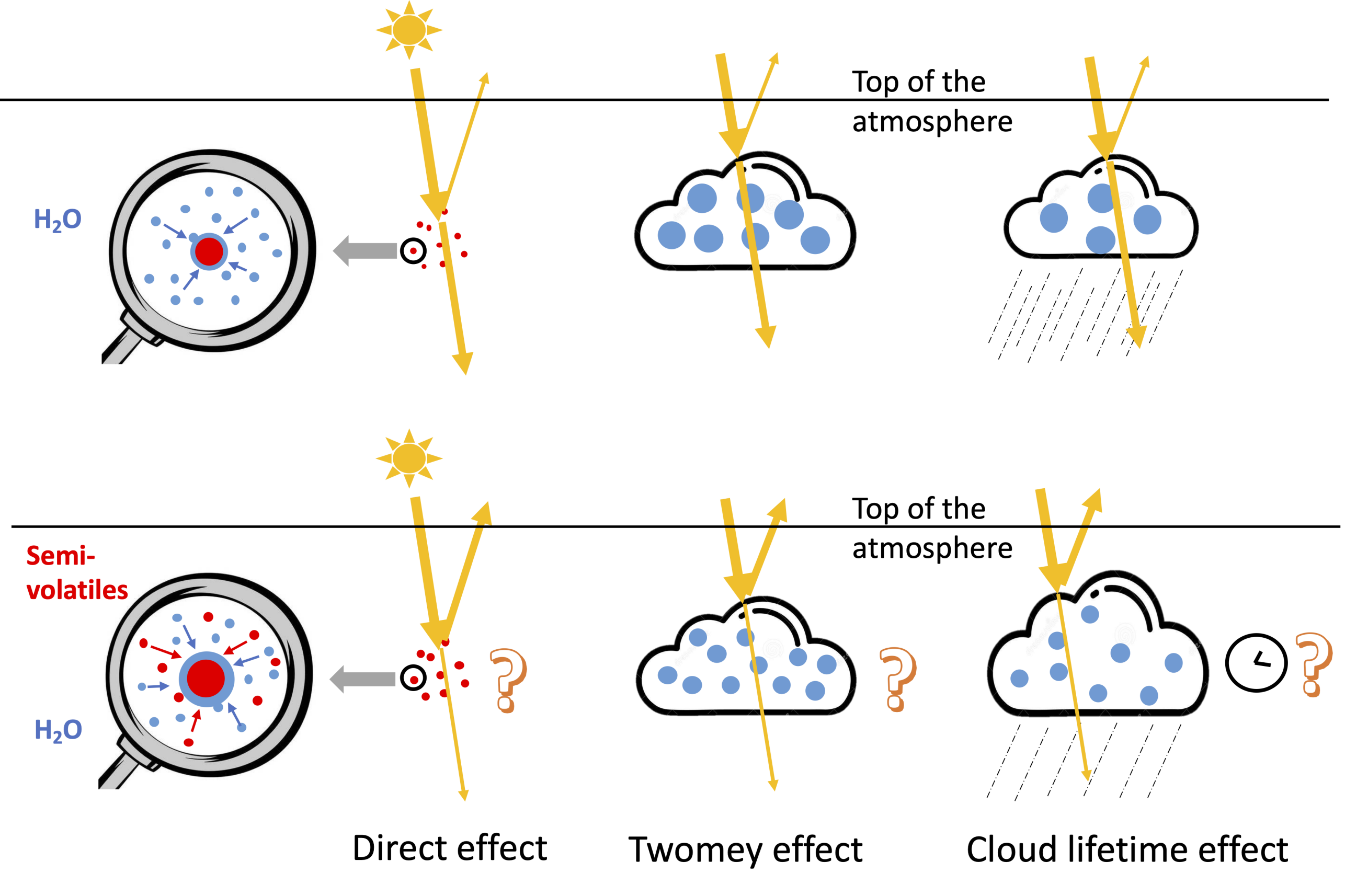Formation of haze and cloud droplets
Significance of semi-volatile compounds on clouds and climate
Semi-volatile compounds are widely observed in the atmosphere globally and usually contribute to over 50% of particulate matter mass worldwide. The co-condensation of semi-volatile compounds and water vapor can facilitate aerosol particle growth and their activation to cloud droplets, which influences cloud formation. This can be important since clouds play a significant role in Earth radiation balance. However, this co-condensation effect is not considered in current General Circulation Models (GCMs), the tools to study climate change. This project therefore aims to understand how much co-condensed semi-volatile vapors (e.g., HNO3, HCl, organic molecules) contribute to aerosol hygroscopic growth in the real atmosphere globally, and how much they can influence cloud formation and climate change. Open-access in-situ observational datasets are combined with a self-developed method and a machine learning algorithm to develop a parameterization to represent the aerosol hygroscopicity enhancement due to the co-condensation effect. This parameterization will be coupled to ICON-HAM and UKESM1 to estimate its impacts on clouds and climate change. The comparison between UKESM1 and ICON-HAM will shed insights on understanding GCMs discrepancies and on directions of further model improvements.
This project is funded by the ETH Fellowship program. For more information, please contact Yu Wang ().

Organic substances influencing haze and clouds
Team: Judith Kleinheins, Mayur Sapkal, Claudia Marcolli, Zamin A. Kanji, Beiping Luo, Thomas Peter and Ulrike Lohmann
In the external pageORACLEcall_made project, we study the role of organics in aerosol–cloud interactions. Cloud droplets in the Earth’s atmosphere form on ubiquitous aerosol particles. At present, predictions of cloud droplet size and number concentration derived from aerosol properties are still poor, leading to large uncertainties in the radiation budget and climate projections. Cloud droplet formation on cloud condensation nuclei (CCN activation) is often investigated in closure studies, where the number of activating particles as estimated by their hygroscopic growth is compared with the number of actually activated particles measured with a CCN counter. Many of these studies resulted in poor agreement, most probably due to effects related to the organic aerosol fraction. The effects potentially causing these discrepancies include:
- Co-condensation of semi-volatile organic substances (SVOCs): A substantial amount of organics in the atmosphere are semi-volatile, which means that they are present both in the gas and in the condensed phase. Their partitioning to the condensed phase increases the larger the volume of the condensed phase is. Hence, when relative humidity rises, SVOCs condense along with water vapor, a process called co-condensation, enhancing the increase in size of the aerosol particles.
- Lowering of the surface tension: Most organics accumulate at the particles’ surface and thereby lower their surface tension. Some organics are amphiphilic and even form a surface layer. Yet, during cloud droplet activation, the organics strongly dilute and it is not clear whether they are still concentrated enough to lower the surface tension. If they were, the supersaturation of water vapor required for cloud droplet activation would be significantly lower.
- Dissociation of weak acids: Organic acids are typically weak acids that considerably dissociate only at high dilution. A high degree of dilution can be reached while an aerosol particle activates to a cloud droplet. A dissociation of the organic acids can increase the Raoult effect and thus enhance droplet growth.
- Non-ideality in Raoult’s law and phase separation: Organic substances with a low oxygen to carbon ratio are sparingly soluble in water and lead to a non-ideal mixing behavior, which affects hygroscopic growth. Furthermore, additional presence of salts in a mixture of water and sparingly soluble organic substances can lead to liquid-liquid-phase separation, which can affect the surface tension of the aerosol particle

We aim to fundamentally advance our understanding of the role organics play in CCN activation through combined experimental and modeling work by investigating the above-explained effects In the long term, ORACLE will improve our ability to predict the number and sizes of cloud droplets, two parameters paramount to precipitation forecasts in numerical weather prediction models and the climate impact of aerosol particles in future climate projections.
